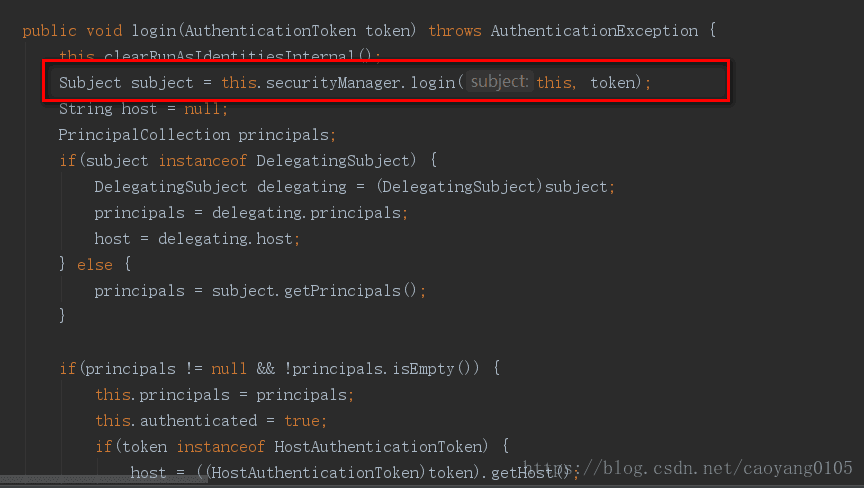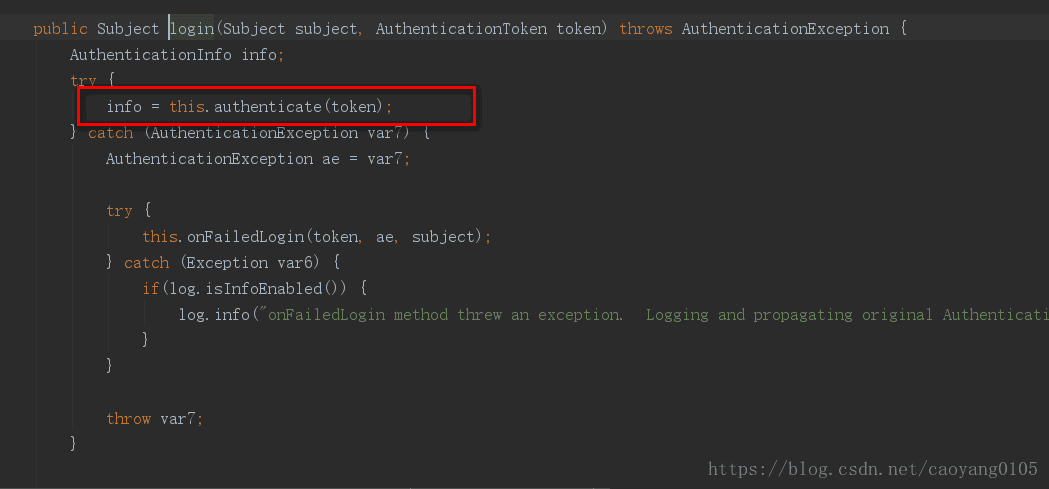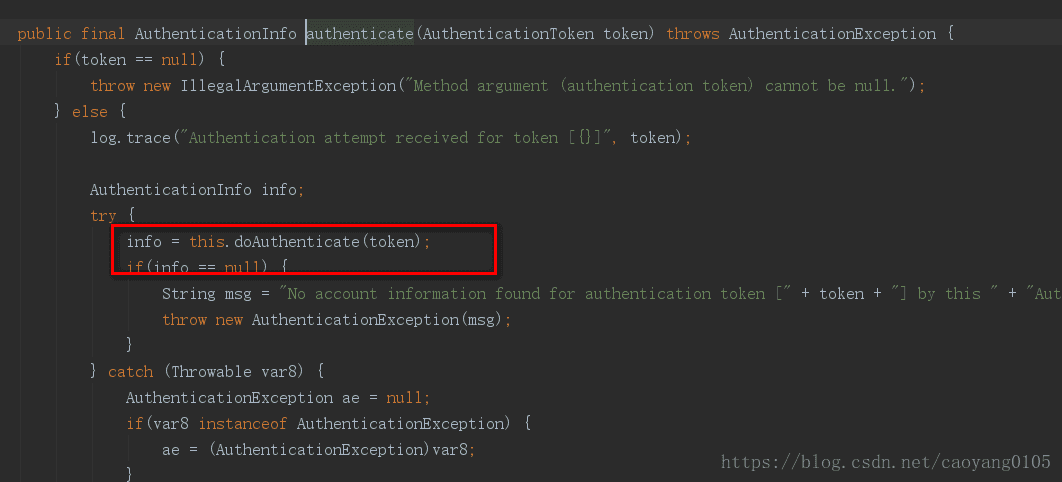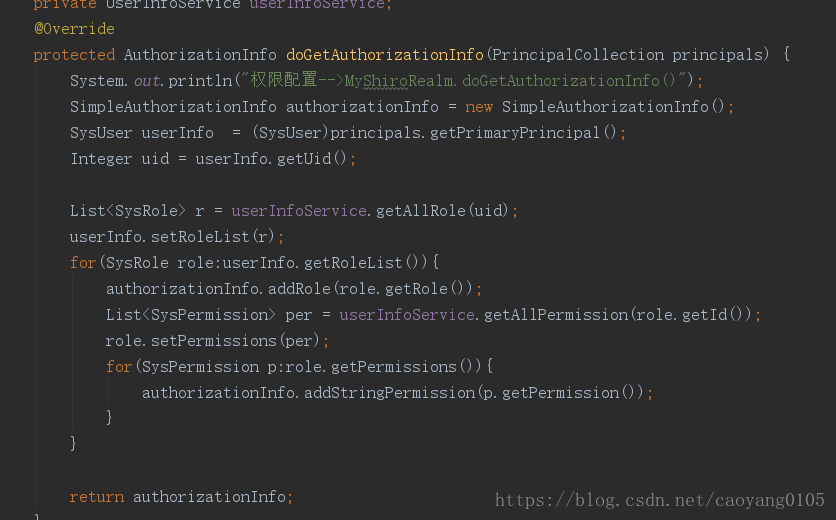先粘出登录的代码
@RequestMapping(value="/submitLogin",method = RequestMethod.POST)
@ResponseBody
public Map<String, Object> submitLogin(String username,String password){
System.out.println(username+"-----"+password);
String msg = "";
Map<String, Object> map = new HashMap<>();
try {
UsernamePasswordToken token = token = new UsernamePasswordToken(username, password);
char[] password1 = token.getPassword();
String s = password1.toString();
System.out.println("*******"+s);
SecurityUtils.getSubject().login(token);
token.setRememberMe(true);
map.put("status",200);
} catch (UnknownAccountException e) {
msg = "UnknownAccountException -- > 账号不存在:";
map.put("status",400);
} catch (IncorrectCredentialsException e){
msg = "IncorrectCredentialsException -- > 密码不正确:";
map.put("status",500);
}catch (Exception exception){
msg = "else >> "+exception;
System.out.println("else -- >" + exception);
}
return map;
}可以看到已经获取到了username和password ,为了接下来的认证过程,我们需要获取subject对象,也就是代表当前登录用户,并且要将username和password两个变量设置到UsernamePasswordToken对象的token中, 调用SecurityUtils.getSubject().login(token)方法,将 token传入
接下来看看login方法的实现:

主要还是用到了securityManager安全管理器
进入securityManager里边的login方法,看看他的实现:

在这个方法中定义了AuthenticationInfo对象来接受从Realm传来的认证信息
进入authenticate方法中
public AuthenticationInfo authenticate(AuthenticationToken token) throws AuthenticationException {
return this.authenticator.authenticate(token);
}发现调用了authenticator的authenticate这个方法
进入this.authenticator.authenticate(token)这个方法中

在这个 类中调用了这个方法,再进去看他的实现
protected AuthenticationInfo doAuthenticate(AuthenticationToken authenticationToken) throws AuthenticationException {
this.assertRealmsConfigured();
Collection<Realm> realms = this.getRealms();
return realms.size() == 1?this.doSingleRealmAuthentication((Realm)realms.iterator().next(), authenticationToken):this.doMultiRealmAuthentication(realms, authenticationToken);
}在这里才是刚才前边的那个authenticator的实现, this.assertRealmsConfigured() 这个方法是判断realm是否存在,不存在则抛出异常,他会根据realm的个数来判断执行哪个方法,上篇中springboot整合shiro我只配置了一个realm,所以他只会执行this.doSingleRealmAuthentication((Realm)realms.iterator().next(), authenticationToken)这个方法,并且会将 realm和token作为参数传入,这里的realm其实就是自己定义的MyShiroRealm
接下来再进入doSingleRealmAuthentication这个方法中,

在这里 他会先判断realm是否支持token
接下来执行else中的getAuthenticationInfo方法

this.getCachedAuthenticationInfo(token)这个方法是从shiro缓存中读取用户信息,如果没有,才从realm中获取信息。如果是第一次登陆,缓存中肯定没有认证信息,所以会执行this.doGetAuthenticationInfo(token)这个方法。
查看this.doGetAuthenticationInfo(token)方法,会发现有这么几个类提供我们选择

其中就有我们自定义的realm,进去

所以 ,上边的doGetAuthorizationInfo是 执行的我们自定义realm中重写的doGetAuthorizationInfo这个方法。这个方法就会从数据库中读取我们所需要的信息,最后封装成SimpleAuthorizationInfo返回去。
现在获取到认证信息了,接下来就是shiro怎么去进行认证,我们返回去看

获取 完信息之后就是进行密码匹配,进入assertCredentialsMatch方法中看一下,

首先 获取一个CredentialsMatcher对象,译为凭证匹配器,这个类的主要作用就是将用户输入的密码一某种计算加密。
再看一下cm.doCredentialsMatch(token,info)

这里会用到equals方法对token中加密的密码和从数据库中取出来的info中的密码进行对比,如果认证相同就返回true,失败就返回false,并抛出AuthenticationException,将info返回到defaultSecurityManager中,到此认证过程结束。